Med surg 1 PDF

| Title | Med surg 1 |
|---|---|
| Author | patience anyaduba |
| Course | Preparation for Registration |
| Institution | University of Essex |
| Pages | 33 |
| File Size | 1 MB |
| File Type | |
| Total Downloads | 29 |
| Total Views | 129 |
Summary
med surg 1...
Description
12/4/2018
Chapter 23 Nursing School Test Banks - Test Bank Go!-all FREE!!
Test Bank Go!—all FREE!! Ho Home me
oth other er test banks
Priv Privacy acy P Policy olicy & Te Terms rms
Chapter 23 Nursing School Test Banks
Re Revie vie view w ffor or Nursing ttest est bank
In sto storre
1.
A perioperative nurse is caring for a postoperative patient. The patient has a shallow respiratory pattern and is reluctant to cough or to begin mobilizing. The nurse should address the patients increased risk for what complication?
A)
Acute respiratory distress syndrome (ARDS)
Project Management A Managerial Approach 9th Edition Meredith TEST BANK $29.99 View Details
B)
Atelectasis
C)
Aspiration
D)
Pulmonary embolism
Ans:
B
Feedback: A shallow, monotonous respiratory pattern coupled with immobility places the patient at an increased risk of developing atelectasis. These specific factors are less likely to result in http://testbankgo.info/chapter-23-2/
Biology The Essentials 1st Edition Hoefnagels TEST BANK $29.99 View Details
1/33
12/4/2018
Chapter 23 Nursing School Test Banks - Test Bank Go!-all FREE!!
pulmonary embolism or aspiration. ARDS involves an exaggerated inflammatory response and does not normally result from factors such as immobility and shallow breathing.
2.
A critical-care nurse is caring for a patient diagnosed with pneumonia as a surgical complication. The nurses assessment reveals that the patient has an increased work of breathing due to copious tracheobronchial secretions. What should the nurse encourage the patient to do?
College Accounting A Contemporary Approach 3rd Edition Haddock TEST BANK $29.99 View Details
A)
Increase oral fluids unless contraindicated.
B)
Call the nurse for oral suctioning, as needed.
C)
Lie in a low Fowlers or supine position.
D)
Increase activity.
Ans:
A
Feedback:
Horngrens Accounting The Managerial Chapters 10th Edition Nobles TEST BANK $29.99 View Details
The nurse should encourage hydration because adequate hydration thins and loosens pulmonary secretions. Oral suctioning is not sufficiently deep to remove tracheobronchial secretions. The patient should have the head of the bed raised, and rest should be promoted to avoid exacerbation of symptoms.
3.
The public health nurse is administering Mantoux tests to children who are being registered for kindergarten in the community. How should the nurse administer this test?
http://testbankgo.info/chapter-23-2/
Database Systems Design Implementation and Management 12th Edition Coronel TEST BANK
2/33
12/4/2018
Chapter 23 Nursing School Test Banks - Test Bank Go!-all FREE!!
A)
B)
Administer intradermal injections into the childrens inner forearms.
$29.99 View Details
Administer intramuscular injections into each childs vastus lateralis.
C)
Administer a subcutaneous injection into each childs umbilical area.
D)
Administer a subcutaneous injection at a 45degree angle into each childs deltoid.
Ans:
A Feedback:
Andersons Business Law and the Legal Environment Standard Volume 22nd Edition Twomey TEST BANK $29.99 View Details
The purified protein derivative (PPD) is always injected into the intradermal layer of the inner aspect of the forearm. The subcutaneous and intramuscular routes are not utilized.
4.
The nurse is caring for a patient who has been in a motor vehicle accident and the care team suspects that the patient has developed pleurisy. Which of the nurses assessment findings would best corroborate this diagnosis?
Fundamentals of Selling Customers for Life through Service 13th Edition Futrell TEST BANK $29.99 View Details
A)
The patient is experiencing painless hemoptysis.
B)
The patients arterial blood gases (ABGs) are normal, but he demonstrates increased work of breathing.
C)
The patients oxygen saturation level is below 88%, but he denies shortness of breath.
http://testbankgo.info/chapter-23-2/
Living with Art 11th Edition Mark Getlein TEST BANK 3/33
12/4/2018
Chapter 23 Nursing School Test Banks - Test Bank Go!-all FREE!!
D)
Ans:
The patients pain intensifies when he coughs or takes a deep breath.
$29.99 View Details
D Feedback:
The key characteristic of pleuritic pain is its relationship to respiratory movement. Taking a deep breath, coughing, or sneezing worsens the pain. The patients ABGs would most likely be abnormal and shortness of breath would be expected.
Business Communication Today 12th Edition Bovee TEST BANK $29.99 View Details
5.
The nurse caring for a patient recently diagnosed with lung disease encourages the patient not to smoke. What is the primary rationale behind this nursing action?
A)
Smoking decreases the amount of mucus production.
B)
Smoke particles compete for binding sites on hemoglobin.
C)
Smoking causes atrophy of the alveoli.
D)
Smoking damages the ciliary cleansing mechanism.
Ans:
D
HIST US History Since 1865 Volume 2 3rd Edition Schultz TEST BANK $29.99 View Details
Feedback:
In addition to irritating the mucous cells of the bronchi and inhibiting the function of alveolar macrophage (scavenger) cells, smoking damages http://testbankgo.info/chapter-23-2/
Business Communication Essentials 5th Edition Bovee TEST BANK 4/33
12/4/2018
Chapter 23 Nursing School Test Banks - Test Bank Go!-all FREE!!
the ciliary cleansing mechanism of the respiratory tract. Smoking also increases the amount of
$29.99 View Details
mucus production and distends the alveoli in the lungs. It reduces the oxygen-carrying capacity of hemoglobin, but not by directly competing for binding sites.
6.
A patient has been brought to the ED by the paramedics. The patient is suspected of having ARDS. What intervention should the nurse first anticipate?
A)
Preparing to assist with intubating the patient
B)
Setting up oxygen at 5 L/minute by nasal cannula
C)
Performing deep suctioning
D)
Setting up a nebulizer to administer
Cognitive Psychology In and Out of the Laboratory 5th Edition Galotti TEST BANK $29.99 View Details
corticosteroids Ans:
A
Feedback:
Understanding Business Ethics 2nd Edition Stanwick TEST BANK $29.99 View Details
A patient who has ARDS usually requires intubation and mechanical ventilation. Oxygen by nasal cannula would likely be insufficient. Deep suctioning and nebulizers may be indicated, but the priority is to secure the airway.
7.
The nurse is caring for a patient who is scheduled for a lobectomy for a diagnosis of lung cancer. While assisting with a subclavian vein central line insertion, the nurse notes the clients oxygen saturation rapidly dropping. The patient
http://testbankgo.info/chapter-23-2/
Microeconomics A Contemporary Introduction 10th Edition McEachern TEST BANK 5/33
12/4/2018
Chapter 23 Nursing School Test Banks - Test Bank Go!-all FREE!!
complains of shortness of breath and becomes tachypneic. The nurse suspects a pneumothorax has developed. Further assessment findings supporting the presence of a pneumothorax include what?
A)
Diminished or absent breath sounds on the affected side
B)
Paradoxical chest wall movement with respirations
C)
Sudden loss of consciousness
D)
Muffled heart sounds
Ans:
A
$29.99 View Details
Guide to TCP IP 4th Edition Carrell TEST BANK $29.99 View Details
See wha whatt stude studen nts sa say y abou aboutt us
Feedback:
In the case of a simple pneumothorax, auscultating the breath sounds will reveal absent or diminished breath sounds on the affected side. Paradoxical chest wall movements occur in flail chest conditions. Sudden loss of consciousness does not typically occur. Muffled or distant heart sounds occur in pericardial tamponade.
8.
The nurse is providing discharge teaching for a patient who developed a pulmonary embolism after total knee surgery. The patient has been converted from heparin to sodium warfarin (Coumadin) anticoagulant therapy. What should the nurse teach the client?
A)
Other test bank test banks
Coumadin will continue to break up the clot over a period of weeks
http://testbankgo.info/chapter-23-2/
6/33
12/4/2018
Chapter 23 Nursing School Test Banks - Test Bank Go!-all FREE!!
B)
Coumadin must be taken concurrent with ASA to achieve anticoagulation.
C)
Anticoagulant therapy usually lasts between 3 and 6 months.
D)
He should take a vitamin supplement containing vitamin K
Ans:
C
Feedback: Anticoagulant therapy prevents further clot formation, but cannot be used to dissolve a clot. The therapy continues for approximately 3 to 6 months and is not combined with ASA. Vitamin K reverses the effect of anticoagulant therapy and normally should not be taken.
9.
A new employee asks the occupational health nurse about measures to prevent inhalation exposure of the substances. Which statement by the nurse will decrease the patients exposure risk to toxic substances?
A)
Position a fan blowing on the toxic substances to prevent the substance from becoming stagnant in the air.
B)
Wear protective attire and devices when working with a toxic substance.
C)
Make sure that you keep your immunizations up to date to prevent respiratory diseases resulting from toxins.
http://testbankgo.info/chapter-23-2/
7/33
12/4/2018
Chapter 23 Nursing School Test Banks - Test Bank Go!-all FREE!!
D)
Always wear a disposable paper face mask when you are working with inhalable toxins.
Ans:
B Feedback:
When working with toxic substances, the employee must wear or use protective devices such as face masks, hoods, or industrial respirators. Immunizations do not confer protection from toxins and a paper mask is normally insufficient protection. Never position a fan directly blowing on the toxic substance as it will disperse the fumes throughout the area.
10.
An x-ray of a trauma patient reveals rib fractures and the patient is diagnosed with a small flail chest injury. Which intervention should the nurse include in the patients plan of care?
A)
Suction the patients airway secretions.
B)
Immobilize the ribs with an abdominal binder.
C)
Prepare the patient for surgery.
D)
Immediately sedate and intubate the patient.
Ans:
A Feedback:
As with rib fracture, treatment of flail chest is usually supportive. Management includes clearing secretions from the lungs, and controlling pain. If only a small segment of the http://testbankgo.info/chapter-23-2/
8/33
12/4/2018
Chapter 23 Nursing School Test Banks - Test Bank Go!-all FREE!!
chest is involved, it is important to clear the airway through positioning, coughing, deep breathing, and suctioning. Intubation is required for severe flail chest injuries, and surgery is required only in rare circumstances to stabilize the flail segment.
11.
The nurse is caring for a patient who is receiving oxygen therapy for pneumonia. How should the nurse best assess whether the patient is hypoxemic?
A)
Assess the patients level of consciousness (LOC).
B)
Assess the patients extremities for signs of cyanosis.
C)
Assess the patients oxygen saturation level.
D)
Review the patients hemoglobin, hematocrit, and red blood cell levels.
Ans:
C
Feedback: The effectiveness of the patients oxygen therapy is assessed by the ABG analysis or pulse oximetry. ABG results may not be readily available. Presence or absence of cyanosis is not an accurate indicator of oxygen effectiveness. The patients LOC may be affected by hypoxia, but not every change in LOC is related to oxygenation. Hemoglobin, hematocrit, and red blood cell levels do not directly reflect current oxygenation status. http://testbankgo.info/chapter-23-2/
9/33
12/4/2018
Chapter 23 Nursing School Test Banks - Test Bank Go!-all FREE!!
12.
An adult patient has tested positive for tuberculosis (TB). While providing patient teaching, what information should the nurse prioritize?
A)
The importance of adhering closely to the prescribed medication regimen
B)
The fact that the disease is a lifelong, chronic condition that will affect ADLs
C)
The fact that TB is self-limiting, but can take up to 2 years to resolve
D)
The need to work closely with the occupational and physical therapists
Ans:
A
Feedback: Successful treatment of TB is highly dependent on careful adherence to the medication regimen. The disease is not self-limiting; occupational and physical therapy are not necessarily indicated. TB is curable.
13.
The nurse is assessing an adult patient following a motor vehicle accident. The nurse observes that the patient has an increased use of accessory muscles and is complaining of chest pain and shortness of breath. The nurse should recognize the possibility of what condition?
A)
Pneumothorax
B)
Anxiety
http://testbankgo.info/chapter-23-2/
10/33
12/4/2018
Chapter 23 Nursing School Test Banks - Test Bank Go!-all FREE!!
C)
Acute bronchitis
D)
Aspiration
Ans:
A Feedback:
If the pneumothorax is large and the lung collapses totally, acute respiratory distress occurs. The patient is anxious, has dyspnea and air hunger, has increased use of the accessory muscles, and may develop central cyanosis from severe hypoxemia. These symptoms are not definitive of pneumothorax, but because of the patients recent trauma they are inconsistent with anxiety, bronchitis, or aspiration.
14.
The nurse at a long-term care facility is assessing each of the residents. Which resident most likely faces the greatest risk for aspiration?
A)
A resident who suffered a severe stroke several weeks ago
B)
A resident with mid-stage Alzheimers disease
C)
A 92-year-old resident who needs extensive help with ADLs
D)
A resident with severe and deforming rheumatoid arthritis
Ans:
A Feedback:
http://testbankgo.info/chapter-23-2/
11/33
12/4/2018
Chapter 23 Nursing School Test Banks - Test Bank Go!-all FREE!!
Aspiration may occur if the patient cannot adequately coordinate protective glottic, laryngeal, and cough reflexes. These reflexes are often affected by stroke. A patient with midstage Alzheimers disease does not likely have the voluntary muscle problems that occur later in the disease. Clients that need help with ADLs or have severe arthritis should not have difficulty swallowing unless it exists secondary to another problem.
15.
The nurse is caring for a patient suspected of having ARDS. What is the most likely diagnostic test ordered in the early stages of this disease to differentiate the patients symptoms from those of a cardiac etiology?
A)
Carboxyhemoglobin level
B)
Brain natriuretic peptide (BNP) level
C)
C-reactive protein (CRP) level
D)
Complete blood count
Ans:
B Feedback:
Common diagnostic tests performed for patients with potential ARDS include plasma brain natriuretic peptide (BNP) levels, echocardiography, and pulmonary artery catheterization. The BNP level is helpful in distinguishing ARDS from cardiogenic pulmonary edema. The carboxyhemoglobin level will be increased in a client with an inhalation http://testbankgo.info/chapter-23-2/
12/33
12/4/2018
Chapter 23 Nursing School Test Banks - Test Bank Go!-all FREE!!
injury, which commonly progresses into ARDS. CRP and CBC levels do not help differentiate from a cardiac problem.
16.
The nurse is caring for a patient at risk for atelectasis. The nurse implements a first-line measure to prevent atelectasis development in the patient. What is an example of a first-line measure to minimize atelectasis?
A)
Incentive spirometry
B)
Intermittent positive-pressure breathing (IPPB)
C)
Positive end-expiratory pressure (PEEP)
D)
Bronchoscopy
Ans:
A
Feedback: Strategies to prevent atelectasis, which include frequent turning, early ambulation, lung-volume expansion maneuvers (deep breathing exercises, incentive spirometry), and coughing, serve as the first-line measures to minimize or treat atelectasis by improving ventilation. In patients who do not respond to first-line measures or who cannot perform deep-breathing exercises, other treatments such as positive end-expiratory pressure (PEEP), continuous or intermittent positive-pressure breathing (IPPB), or bronchoscopy may be used.
17.
While planning a patients care, the nurse
http://testbankgo.info/chapter-23-2/
13/33
12/4/2018
Chapter 23 Nursing School Test Banks - Test Bank Go!-all FREE!!
identifies nursing actions to minimize the patients pleuritic pain. Which intervention should the nurse include in the plan of care? A)
Avoid actions that will cause the patient to breathe deeply.
B)
Ambulate the patient at least three times daily.
C)
Arrange for a soft-textured diet and increased fluid intake.
D)
Encourage the patient to speak as little as possible
Ans:
A
Feedback: The key characteristic of pleuritic pain is its relationship to respiratory movement. Taking a deep breath, coughing, or sneezing worsens the pain. A soft diet is not necessarily ind...
Similar Free PDFs

Med surg 1
- 33 Pages

ATI Med Surg 1 - ATI
- 22 Pages
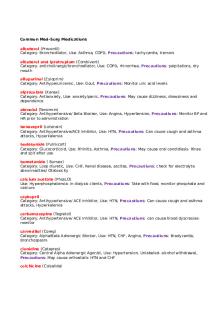
Common Med Surg Meds
- 7 Pages

Med surg dorris bowman
- 4 Pages
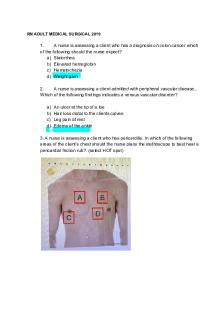
Med surg - notes
- 28 Pages
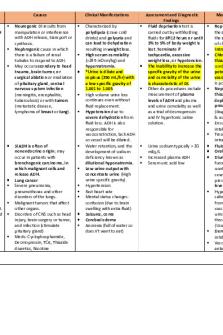
Med-Surg Endocrine
- 11 Pages
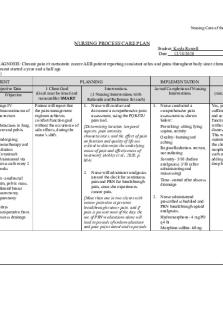
Med Surg- Care Plan
- 6 Pages
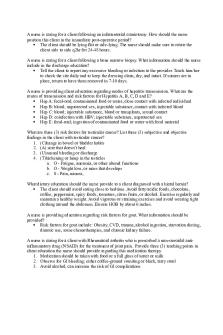
Med-Surg Capstone remediation
- 4 Pages

Med Surg Exam 3
- 19 Pages
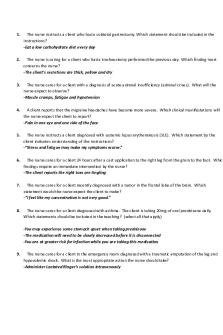
Kaplan med surg 2
- 8 Pages

med surg review questions
- 7 Pages

Adv med surg remediation
- 2 Pages
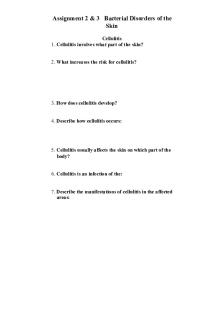
Med SURG; assignment 2
- 9 Pages

Med Surg ATI Remediation
- 6 Pages
Popular Institutions
- Tinajero National High School - Annex
- Politeknik Caltex Riau
- Yokohama City University
- SGT University
- University of Al-Qadisiyah
- Divine Word College of Vigan
- Techniek College Rotterdam
- Universidade de Santiago
- Universiti Teknologi MARA Cawangan Johor Kampus Pasir Gudang
- Poltekkes Kemenkes Yogyakarta
- Baguio City National High School
- Colegio san marcos
- preparatoria uno
- Centro de Bachillerato Tecnológico Industrial y de Servicios No. 107
- Dalian Maritime University
- Quang Trung Secondary School
- Colegio Tecnológico en Informática
- Corporación Regional de Educación Superior
- Grupo CEDVA
- Dar Al Uloom University
- Centro de Estudios Preuniversitarios de la Universidad Nacional de Ingeniería
- 上智大学
- Aakash International School, Nuna Majara
- San Felipe Neri Catholic School
- Kang Chiao International School - New Taipei City
- Misamis Occidental National High School
- Institución Educativa Escuela Normal Juan Ladrilleros
- Kolehiyo ng Pantukan
- Batanes State College
- Instituto Continental
- Sekolah Menengah Kejuruan Kesehatan Kaltara (Tarakan)
- Colegio de La Inmaculada Concepcion - Cebu

